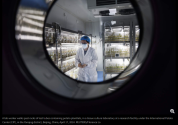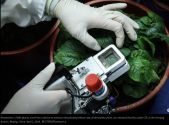no, let's just keep it here. We don't need so many threads.Can we just have a personal electronics thread? Would be nice to have a dedicated place to follow laptop smartphone and other personal device announcements.
You are using an out of date browser. It may not display this or other websites correctly.
You should upgrade or use an alternative browser.
You should upgrade or use an alternative browser.
News on China's scientific and technological development.
- Thread starter Quickie
- Start date
"Construction of China's first solution-type medical isotope test reactor is under way in Sichuan Province.
Once complete in 2027, the center will produce two of the most commonly used medical isotopes, iodine-131, which are used to detect thyroid cancer and molybdenum-99 which is used to diagnose heart disease and other cancers."
Once complete in 2027, the center will produce two of the most commonly used medical isotopes, iodine-131, which are used to detect thyroid cancer and molybdenum-99 which is used to diagnose heart disease and other cancers."
Xiaomi building up a gigafactory right now for smart home products.
China scientists rush to climate-proof potatoes
China is the world’s biggest producer of potatoes, which are crucial to global food security because of their high yield relative to other staple crops.
But they are particularly vulnerable to heat, and climate change, driven by fossil fuel emissions, is pushing temperatures to dangerous new heights while also worsening drought and flooding.
With an urgent need to protect food supplies, Li, a researcher at the International Potato Center (CIP) in Beijing, is leading a three-year study into the effects of higher temperatures on the vegetable. His team is focusing on China’s two most common varieties.
Li’s team grew their crop over three months in a walk-in chamber set at 3 degrees Celsius above the current average temperature in northern Hebei and Inner Mongolia, the higher altitude provinces where potatoes are usually grown in China.
Their research, published in the journal Climate Smart Agriculture this month, found the higher temperatures accelerated tuber growth by 10 days, but cut potato yields by more than half.
Under current climate policies, the world is facing as much as 3.1 C of warming above pre-industrial levels by 2100, according to a United Nations report released in October.


Xiaomi has seen its market share in various smart home products increase significantly and plans to open up many overseas stores for all of this.
"Introducing "potato rice"! China has recently launched its first potato-to-rice production line in Zhaotong, Yunnan that turns potatoes into rice by changing the properties of macromolecules to reshape the starch via self-developed tech.
The production line has an annual output of 1,000 tonnes of the "potato rice" boasting cheaper price and longer-term storage. "
The production line has an annual output of 1,000 tonnes of the "potato rice" boasting cheaper price and longer-term storage. "
broadsword
Brigadier
Diamonds are our friend also
Higher-density storage technique could allow diamond disk to store equivalent of 2,000 Blu-ray discs
by Bob Yirka , Phys.org
The concept of diamond storage medium. Credit: Nature Photonics (2024). DOI: 10.1038/s41566-024-01573-1
A team of engineers at the University of Science and Technology of China has developed a new way to code data onto a diamond with higher density than prior methods. In their paper in the journal Nature Photonics, the group notes that such optical discs could hold data safely at room temperature for millions of years.
Prior research has shown that it is possible to code data onto a diamond, allowing for much longer data than any other known method. But such efforts have produced low-density storage. In this new effort, the research team developed a new method for etching data onto a diamond that allows for much denser data storage, and thus for storing more information onto a single diamond.
In their work, the researchers used diamond pieces just a few millimeters in length—they were pursuing a proof of concept, not a true storage medium. Future versions, they note, could be the size of a Blu-ray disc. The new method involved the use of a to remove single carbon atoms from the surface of the diamond, leaving a tiny cavity. The cavity, the researchers note, exhibits a certain level of brightness when another laser is shone on it.
The researchers found that by controlling the energy levels of the writing laser, they could control the degree of brightness of a given site on the diamond by removing certain numbers of atoms. In this way, data can be stored as empty spaces with various brightness levels. A reader laser could then be used to determine the level of a given site, and use that to decode the information.
The research team tested their idea by coding stored images onto a tiny diamond chip and found their method was 99% accurate. They acknowledge that their method is not currently economically viable, however, due to the high cost of the laser, but suggest it could be used for certain high-importance applications.
broadsword
Brigadier
"Introducing "potato rice"! China has recently launched its first potato-to-rice production line in Zhaotong, Yunnan that turns potatoes into rice by changing the properties of macromolecules to reshape the starch via self-developed tech.
The production line has an annual output of 1,000 tonnes of the "potato rice" boasting cheaper price and longer-term storage. "
This is great and has huge marketing potential. Potatoes are a powerhouse of nutrients.
Chines scientists from CAS developed a technology to "split" image sensor pixels for higher photo resolutions. Dubbed as hyper imaging sampling, this method currently can already increase photo resolution up to 5k by 5k for sensors of only 1k by 1k pixels for example. And there is still room for even higher increases.
If I am reading it correctly, to use this technology it requires to pre-scan an image sensor with certain kind of laser to determine the "quantum efficiency distribution" within each pixel. Photos of motion objects produced by the sensor can then be enhanced accordingly. This should have huge applications in fields like remote sensing and security surveillance.
If I am reading it correctly, to use this technology it requires to pre-scan an image sensor with certain kind of laser to determine the "quantum efficiency distribution" within each pixel. Photos of motion objects produced by the sensor can then be enhanced accordingly. This should have huge applications in fields like remote sensing and security surveillance.
11 月 27 日消息,数字图像传感器(CCD、CMOS)的像素规模和性能是影响天文、遥感等领域成像质量的核心。目前,图像传感器芯片制造已趋近技术极限。
IT之家从中国科学院空天信息创新研究院官网获悉,空天院张泽研究员团队首次实现像素“分割”成像,成功开发出超采样成像技术,该技术能够显著提升图像传感器的像素分辨率和成像质量。相关研究成果发表于《激光与光子学评论》杂志。
什么是超采样成像?空天院团队负责人、研究员张泽说,数字图像传感器的工作原理本质上对光场进行采样显像的过程,类似于传统的胶卷。根据奈奎斯特采样定律,一个信息光场周期至少需要两个像素采样才能不丢失信息,因此图像传感器的像素分辨率是图像显示的细节极限。超采样成像是突破像素分辨率极限,利用少数像素传感器实现大规模像素显像能力的技术。
自从数字图像传感器取代胶卷以来,成像技术一直受传感器采样极限的困扰。人类制造的数字图像传感器(最小感光单元为像素)在像素尺寸、数量规模和响应均匀性上远不及胶卷(最小感光单元为卤化银分子)。依据当前的制造水平,数字图像传感器的像素分辨率和成像质量难以大幅提升。超采样成像技术绕过了芯片制造水平的限制,为突破像素分辨率成像提供了一条鲁棒性很强的技术途径。“鲁棒性指的是在面对内部结构或外部环境改变时,仍然能够维持其功能稳定运行的能力。超采样成像技术具备这样的稳定性。”张泽介绍道。
在实现原理上,空天院科研团队采用稳态激光技术扫描数字图像传感器,通过稳态光场表达式和输出图像矩阵的关联关系,精确求解出了图像传感器像素内量子效率分布。当使用相机拍摄动态目标,或者移动相机拍摄静态场景时,利用获取的像素内量子效率和像素细分算法,即可以突破原始像素分辨率,实现超采样成像。据悉,稳态激光技术是由该团队首创的锋芒稳态激光技术演化而来,在原理上具有极稳定的光场形式。
超采样成像技术目前可以把像素规模提高 5×5 倍,即利用 1k×1k 的芯片可以实现 5k×5k 像素分辨率的成像。并且随着标校精度的进一步提升,像素分辨率还具有进一步的提升空间。张泽科普地介绍,打个比方,原有像素是一个方块,通过该技术可以将像素分割,等效变成 25 个像素(方块),对应着像素规模提升了 25 倍。
该项技术具有很大的应用发展潜力。以红外图像传感器为例,市场化的成像芯片分辨率一般在 2k×2k 以下,3k×3k、4k×4k 的成像芯片尚未有成熟的商用产品,而采用超采样成像技术则可以利用 2k×2k 芯片实现 8k×8k 以上的像素分辨率,这在光学遥感、安防等成像领域具有广阔的应用前景。
目前,该技术已分别在室内、室外对无人机、建筑、高铁、月亮等目标进行了成像试验,显示了良好的技术鲁棒性。
in the context of biogeochemistry, PFAS is small molecule. I don't have to tell you that a polymer's properties are vastly different than its monomer, such as how ethylene and polyethylene have very little in common.Polymeric PFASs such as polytetrafluoroethylene (PTFE) is more well known by the trade name as Teflon.
